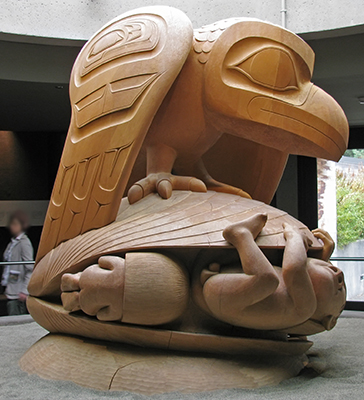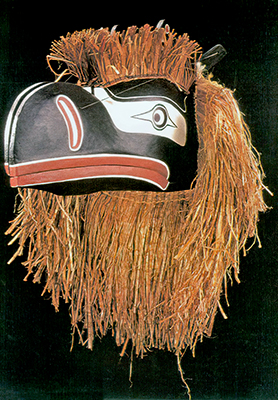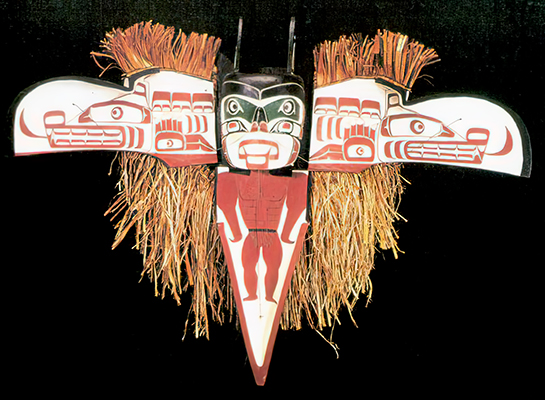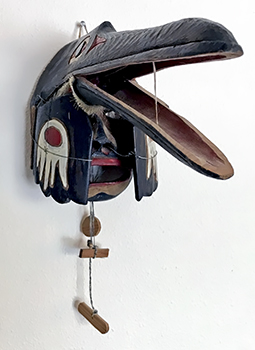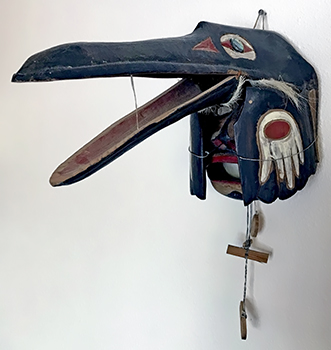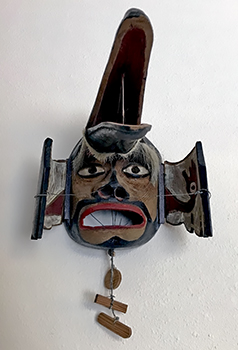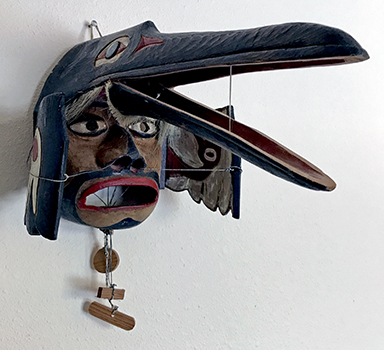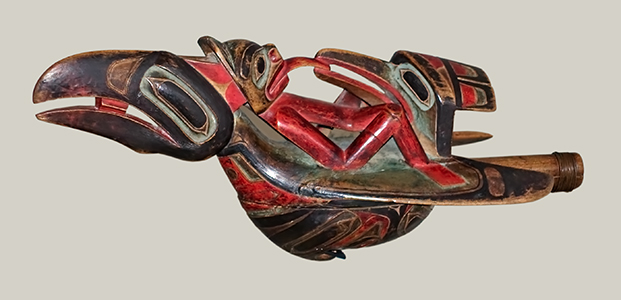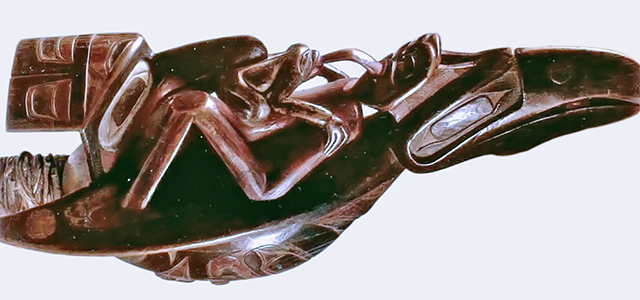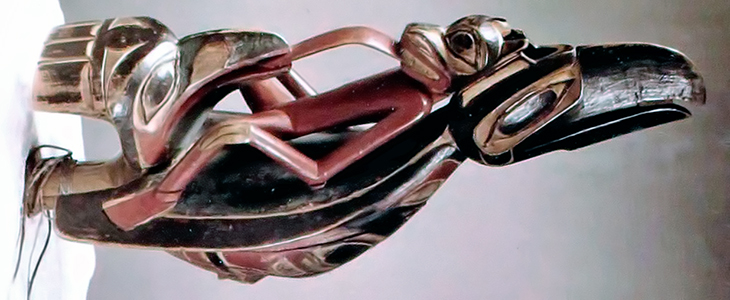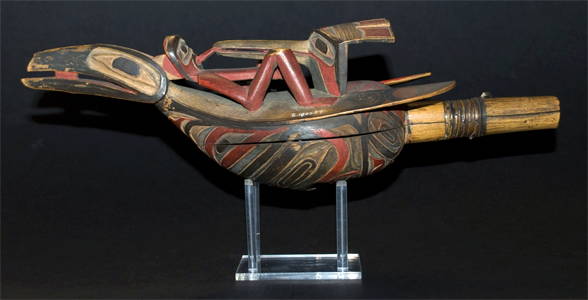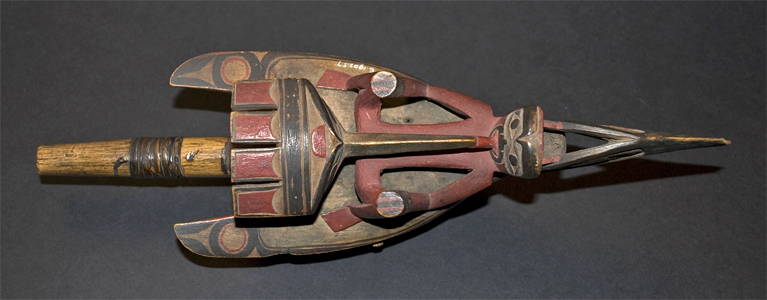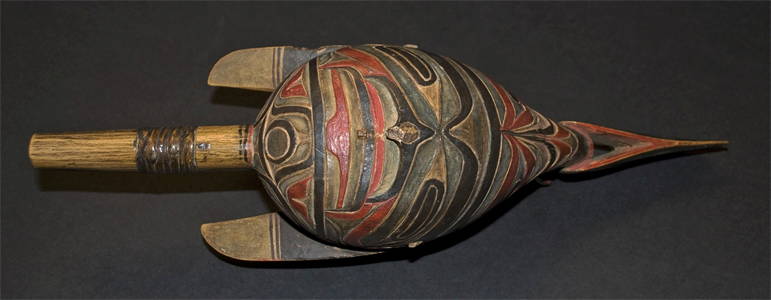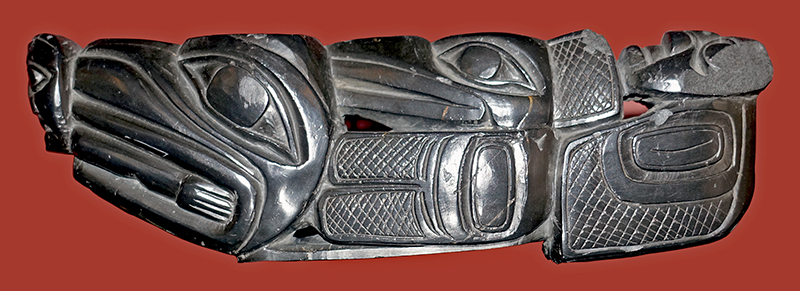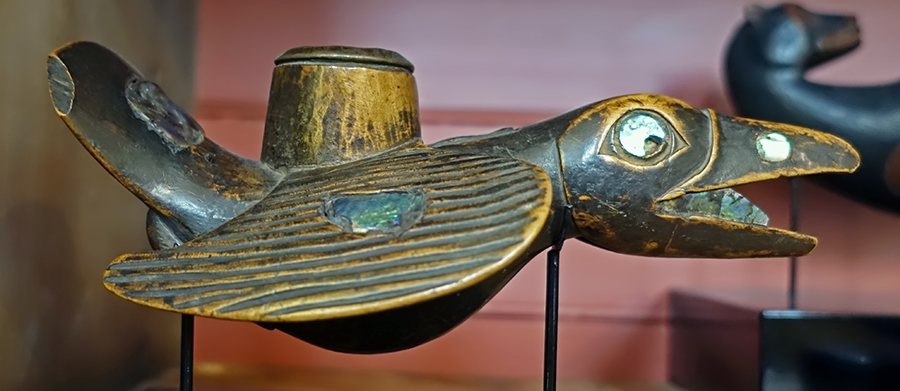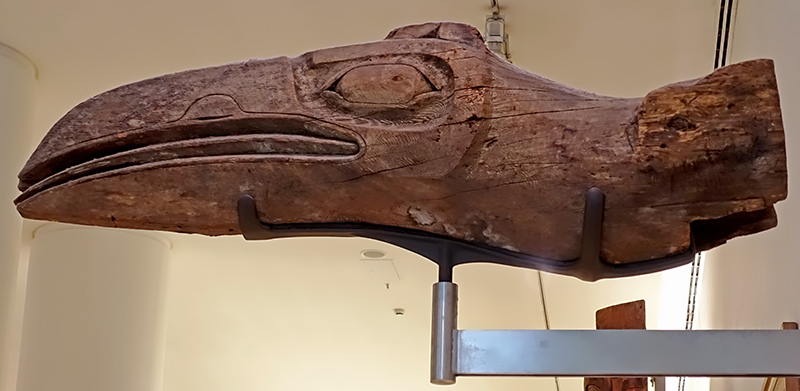Back to Don's Maps
 Back to Archaeological Sites
Back to Archaeological Sites
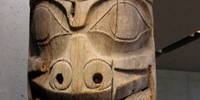 Back to Pacific NW Coast index
Back to Pacific NW Coast index
The Raven

The Raven
The Raven and the First Men, by Bill Reid.
Photo: Don Hitchcock 2012
Source: Display, Museum of Anthropology, University of British Columbia
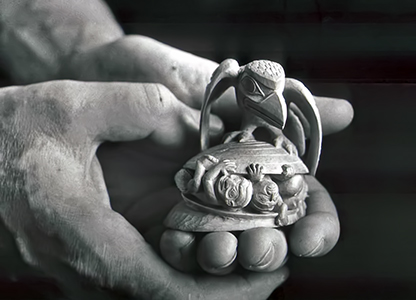
Bill Reid (1920 - 1998) is one of Canada’s most distinguished sculptors. One of the greatest achievements in his illustrious career is the monumental sculpture, The Raven and the First Men.
Bill Reid holding his carving, 'The Raven Discovering Mankind in a Clamshell,' 1970, which was inspired by the carvings of his Great Uncle, Charles Edenshaw.
Photo: Ulli Steltzer
Source and text: http://painterskeys.com/bill-reid/#prettyPhoto
According to Haida legend, the Raven found himself alone one day on Rose Spit beach, on Haida Gwaii. Suddenly, he saw an extraordinary clamshell at his feet, and protruding from it were a number of small creatures.
The Raven coaxed them to leave the shell to join him in his wonderful world. Some were hesitant at first, but eventually, overcome by curiosity, they emerged from the partly open clamshell to become the first Haida.
Photo: Don Hitchcock 2012
Source: Display, Museum of Anthropology, University of British Columbia
Text: https://moa.ubc.ca/wp-content/uploads/2014/08/Sourcebooks-Raven_and_the_First_Men.pdf
A Northwest Coast Native Myth 'Raven was not thought of as a god. He was thought of as the transformer, the trickster. He was the being that changed things - sometimes quite by accident, sometimes on purpose.'
—Christian White, Haida artist
In northern Northwest Coast mythology, Raven is the powerful figure who transforms the world. Stories tell how Raven created the land, released the people from a cockle shell, and brought them fire. Raven stole the light and brought it out to light up the world. Yet Raven is a trickster—often selfish, hungry, and mischievous. He changes the world only by cleverly deceiving others in his never - ending quest for food.
In Northwest Coast art, ravens signify the many adventures of Raven in the early days of the world. Those who know the stories cannot help being reminded of the trickster whenever they see a raven.
Myths explain the natural world, describe the origin of a clan or tell how the clan acquired rights to perform a particular ceremony. This excerpt is from a Raven story published by Haida artist Bill Reid in 1984.
How Raven Brought Light to the World 'At that time the whole world was dark. Inky, pitchy, all-consuming dark, blacker than a thousand stormy winter midnights, blacker than anything anywhere has been since.'
'The reason for all this blackness has to do with the old man in the house by the river, who had a box, which contained a box, which contained a box, which contained an infinite number of boxes, each nestled in a box slightly larger than itself until finally there was a box so small all it could contain was all the light in the universe.'
In the story, the old man hides the light because he's afraid to see whether or not his daughter is ugly. In a ploy to steal the light, Raven shrinks himself to become a hemlock needle in a basket of drinking water so that the daughter swallows him. Soon Raven is reborn from her as a raven/human child. The old man accepts him as a grandson, and soon Raven begins begging that he open the boxes, one after another, each time pleading and crying until the old man yields.
When the old man finally opens the box containing the light, Raven grabs it and flies out of the house - causing light to spread throughout the world and revealing that the old man's daughter is as beautiful as the fronds of a hemlock tree.
As Raven flies away, Eagle sees him and tries to steal the light, causing Raven to drop some of it, which becomes the Moon and the stars.
Text above: https://www.amnh.org/exhibitions/totems-to-turquoise/native-american-cosmology/raven-the-trickster
Potlatches and ceremonies
As a way of honouring the natural milestones of Native American life, the Kwakwaka'wakw people, a Native American tribe that originates in the Pacific Northwest Coast, celebrates Potlatch. Potlatch is a tradition that includes wearing transformation masks, singing, and dancing. The ceremony is meant to celebrate the rituals of name-giving, inducting a new chief of the tribe, and honoring a death or marriage.
Potlatch ceremonies were used to establish social order, distribute resources and convey information to the clan. Typically, these masks were carved by master carvers of the First Nations of the Pacific Northwest Coastal region.
The word 'Potlatch' comes from the Chinook word 'to give.' Potlatch ceremonies were conducted in a big community space called the Big House. Frequently, these ceremonies involve the telling of the origin story of the first Nations' group or clan.
Settlers, missionaries and the Canadian government sought to end the Potlatch because they wanted the indigenous people to assimilate to Anglo-Saxon beliefs and customs. In 1884, the Canadian government started a ban on Potlatch ceremonies that lasted until 1969.
Text above: Wikipedia
Raven Masks
Raven/Sisutl transformation mask.
A Raven/Sisutl transformation mask in the permanent collection of The Children’s Museum of Indianapolis.
This modern piece for exhibition illustrates an alternative method for revealing the mythical being hidden inside the mask. The lower beak is able to be manipulated for speech, and the upper beak has been split to allow it to open up to show the mythical being behind it.
In addition, the lower beak in this rendition forms the body of the mythical being when the mask is in its fully open position.
Artist: Oscar Matilpi, Kwakwaka'wakw Nation, 1996
Photo: Randy Johnson
Source: This image was provided to Wikimedia Commons by The Children's Museum of Indianapolis as part of an ongoing cooperative project. The artifact represented in the image is part of the permanent collection of The Children’s Museum of Indianapolis.
Permission: Creative Commons Attribution-Share Alike 3.0 Unported license
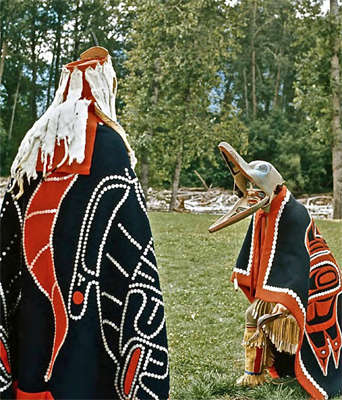
Button Blankets and Transformation Masks
Ksan carvers and dancers, Walter Harris with back to camera, Art Strerrit dancing with mask in background. Ksan village.
Language Group: Tsimshian
Sub-language Group: Gitxsan
Village: Ksan Historical Village
Photo: © G.F. MacDonald Collection, 1972
Permission: Courtesy George MacDonald, Director, Bill Reid Centre for NWC Art Studies at Simon Fraser University, Vancouver, BC.
An important transformation mask
The Pacific Northwest Coast First Nations, and particularly the Kwakwaka’wakw Nation, have a tradition of transformation masks, which allow the performer/dancer to change from an animal such as the raven into a mythical being. The masks and capes used are often part of performances at Potlatch ceremonies. The masks have cords to open and move parts of the mask, animating it in order to tell stories and sing songs.This mask may be from an artist of the Kwakwaka’wakw Nation.
Typically, the dancer tells or sings a story, accompanied by movements of the mask, allowing the audience to see the mask apparently talking, as (for the raven or eagle masks) the beak opens and closes, giving the impression of speech coming from the dancer.
At the culmination of the story, the dancer/performer is able to suddenly, to great effect, open the beak of the bird fully, or in this case open the wings, to reveal the face of a humanoid, powerful, mythical being.
This particular mask shown below is important and more versatile than most because it allows the performer to switch far more dramatically from telling the story to the denouement of revealing the face of the mythical being.
In masks with the face between the upper and lower beaks of the raven or eagle, this revelation is preempted by the inadvertent and unavoidable showing of the mask within the beak. In the case of this mask, the change from the raven telling a story, to the presentation of the mythical being is far more dramatic and impressive.
Other masks such as that of Eagle Mask closed, from Alert Bay, Vancouver Island, by a Kwakwaka’wakw artist, have achieved the same result by splitting the upper beak into two halves to reveal the mythical being, while preserving the lower movable beak for the first part of the performance, where the eagle is 'speaking' from the mask.
Kilroy-Ewbank (2021) is a good reference on transformation masks. Dr Kilroy-Ewbank writes:
Kwakwaka’wakw bands are arranged into four clans (Killer Whale, Eagle, Raven, and Wolf clans). The clans are divided into numayn (or ‘na’mina), which can be loosely translated as 'group of fellows of the same kind' (essentially groups that shared a common ancestor). Numayns were responsible for safe-guarding crest symbols and for conveying their specific rights - which might include access to natural resources (like salmon fishing areas) and rights to sacred names and dances that related to a numayn's ancestor or the group’s origins. The numayn were ranked, and typically only one person could fill a spot at any given moment in time. Each rank entailed specific rights, including ceremonial privileges - like the right to wear a mask such as the Brooklyn Museum's Thunderbird transformation mask. Animal transformation masks contained crests for a given numayn. Ancestral entities and supernatural forces temporarily embody dancers wearing these masks and other ceremonial regalia.
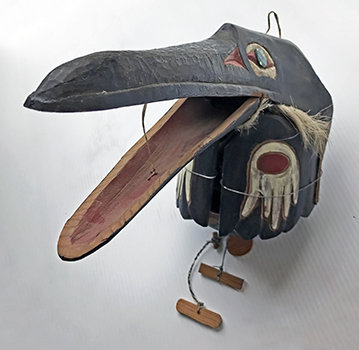
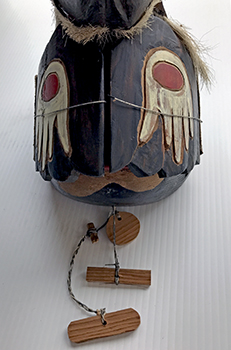
The wings close, completely hiding the mythical figure inside.
On each of the wings is a carved white hand, decorated with a red spot.
Photos: Courtesy of the owner
The mask has a movable lower beak, allowing the Raven to 'speak'.
Photos: Courtesy of the owner
The cords which control the beak and wings have differently shaped wooden tags, which allow the performer to immediately know which cord is which.
Photos: Courtesy of the owner
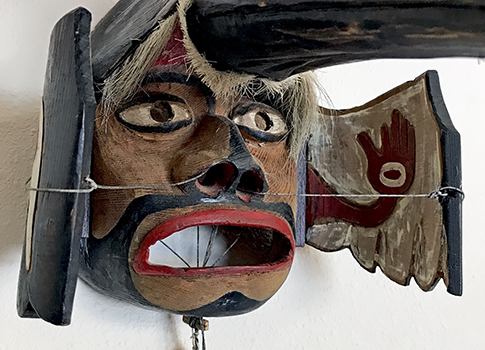
On the inside of each wing is a red hand on which a white, red centred eye has been painted on the palm.
Since this unusual design is repeated on the outside of the wing as well, it would appear to be an identifier of some kind, possibly the numayn to which the carver belonged.
Photo: Courtesy of the owner
The dramatic possibilities of this mask in the hands of a master performer are endless.
Photo: Courtesy of the owner
Raven Rattles
Raven rattles, 19th century Tsimshian.
Most often associated with shamanic practices on the Northwest Coast, raven rattles are held oriented with the bird's beak pointing down when used in dance. Additionally, rattles like this are used to channel a shaman's spirit guide and can be used in healing ceremonies.
Much of the symbolism associated with this rattle comments on the transmission of power from one figure to the next - the raven to humankind in general (as oral tradition states) and the kingfisher to the prone figure on the raven's back.
The prone figure is personified with a face of a wolf on the lower object, perhaps a guide to the owner of the rattle, and by another animal on the upper rattle, evidenced by the large ears on top of the head. Rattles are considered extremely personal objects and bear specific symbolism and power known only by those who understand their meaning.
As symbols of power, rattles are also kept by clan leaders. Carved in two pieces and assembled using wooden pins to secure the halves, a rattle usually contains small stones or seeds. Polychrome adornment exhibits the pale blue pigmentation common during the late nineteenth century. It is common for raven rattles to be further adorned with feathers, fur, and beads, particularly along the seam of the two halves and at the handle base.
In both these examples, the raven holds the box containing the sun in their beak.
Photo (above): Don Hitchcock 2018
Source: Original, British Museum
Photo (below): Skidegate, British Columbia, Canada
Culture: Native American (Tsimshian)
Medium: Cedar, pebbles, polychrome
Length 310 mm, depth 103 mm, width 105 mm
Classification: Idiophone-Shaken-rattle
Accession Number: 89.4.611
Source and text: https://www.metmuseum.org/art/collection/search/501227
Permission: Public Domain
General description of the Raven Rattles
Adapted from Gould (1973)
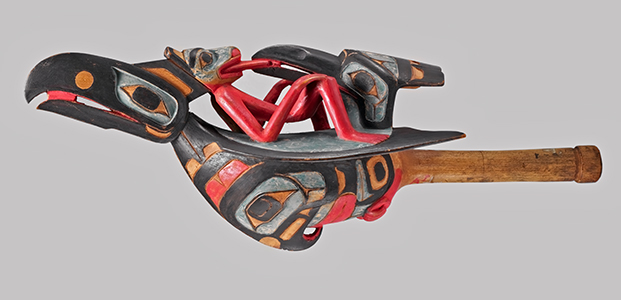
• The over-all shape of the rattle is that of a bird, wings partially spread. In the bill of the bird's head of the rattle is a small object.
Photo: Don Hitchcock 2018
Source: Original, British Museum
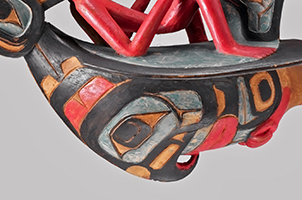
• Carved on the belly of the bird and on the tail of the bird are faces. Creatures with faces on their bellies and tails are fairly common in Northwest Coast representations, particularly when depicted on two dimensional surfaces. The significance of faces on bellies and tails is thus a more general problem in the iconography of Northwest Coast art, and one that has not yet been worked out.
The face on the belly of the rattle has the following distinctive characteristics: a protruding beak or nose that curves around and touches the mouth of the face. This is a fairly common, though enigmatic, motif in Northwest Coast art. Below the mouth and towards the handle of the rattle there is the suggestion of another set of 'eyes'.
Photo: Don Hitchcock 2018
Source: Original, British Museum
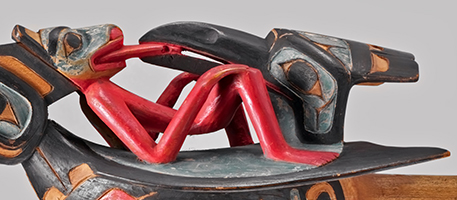
• On the tail of the rattle is the head of another bird. Sometimes it faces the handle of the rattle, sometimes it faces the head. Like the face on the belly of the rattle, faces on the tails of creatures are also a frequent occurrence in Northwest Coast representations. But like the face on the belly of the rattle it also seems to have an identity quite apart from merely being a part of the body of the rattle.
Photo: Don Hitchcock 2018
Source: Original, British Museum
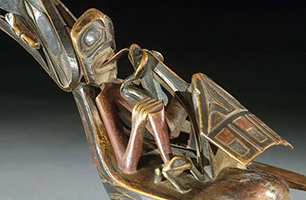
• Also on the back of the rattle is a reclining human-like figure, head usually resting on the neck of the rattle, knees flexed, and hands resting on its knees. Facing the figure, either sitting on the belly of the creature or held in some cases in the mouth of a long-billed bird that is the tail of the rattle, is a frog-like creature. Extending between the mouths of the reclining figure and the 'frog' is a tongue. On some rattles the frog is absent and the tongue extends between the mouth of the human-like figure and the long-billed bird facing it.
Rights Statement: Creative Commons-BY, Brooklyn Museum photograph
Source: http://www.brooklynmuseum.org/opencollection/objects/132835/Raven_Rattle/
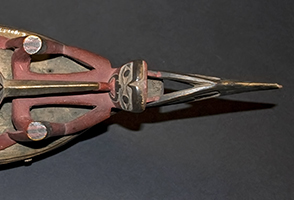
• Another feature of all rattles is noteworthy, although it is difficult to classify, and that is the space carved through the neck of the rattle. This is readily apparent when the rattle is viewed from its dorsal or ventral side. Since there seems to be no structural necessity for it, it might have an iconographic significance.
Photo: http://www.rrnpilot.org/items/160286
Consistent features of all the raven rattles, and their variations
The overall shape of the rattle is that of a bird in whose beak a small object is carried and whose wings are partially spread. On the back of the rattle is a reclining figure sharing a tongue with some other creature (it is difficult to tell whether the tongue extends from the mouth of the figure or into it).
On the belly of the rattle is always a face with a protruding recurved beak or nose, and a mouth. These are the constants.
The variations occurring within this format are minor and three in number, and occur in the reclining figure, joined tongue motif.
Examples of all three variations of raven rattle have been collected from all Northwest Coast cultures where raven rattles are found, so these variations in format do not seem to sort out according to region.
Variation 1:
The creature at the other end of the tongue from the reclining figure is a frog, and in this case the head on the tail of the rattle is facing away toward the handle.
Photo: PM 96-2, Haida, B.C. Provincial Museum of Natural History and Anthropology
Proximal source: Gould (1973)
Variation 2:
The creature at the other end of the tongue from the reclining figure is a frog in the bill of the bird's head facing the reclining figure.
Photo: NMC-VII-B-30 (1283), Haida, Collected by Mackenzie-Tolmie in 1884, National Museum of Canada
Proximal source: Gould (1973)
Variation 3:
The frog is omitted and the reclining figure is joining tongues with a long-billed bird's head.
Photo: NMC-VII-C-15 (180), Tsimshian., Collected by I.W. Powell in 1897, National Museum of Canada
Proximal source: Gould (1973)
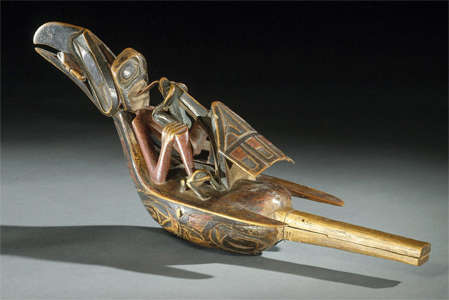
Raven Rattle
Said to originate in the north, perhaps among the Tsimshian, the raven rattle is now considered an item of traditional regalia throughout the Northwest Coast. Chiefs use these rattles as part of their ceremonial dress in dances. This rattle depicts a shaman on the back of a raven. The raven has a frog in its mouth, another frog touches the shaman's tongue, and frogs are on the feet. The bottom also has a raven carved with abstracted figures.
All these representations are transformative animals that relate to the legendary stories of the tribe, and the sound of rattles forms a conduit to the supernatural world when the rattles are employed by shamans. The use of the raven rattle always implies power. For example, it is used in dances that demonstrate the status of the chief, who has a hereditary right to use it.
Rights Statement: Creative Commons-BY
Brooklyn Museum photograph
Source: http://www.brooklynmuseum.org/opencollection/objects/132835/Raven_Rattle/
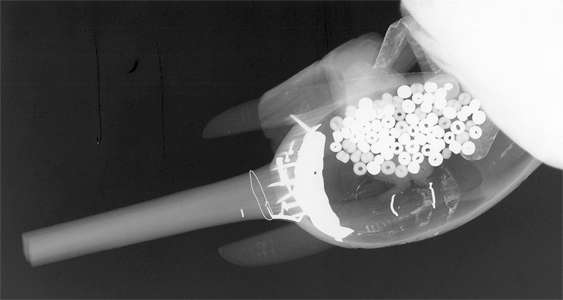
This is an xray of the Raven Rattle above, showing the beads inside that make the characteristic noise of the rattle when shaken.
Culture: Tsimshian, Native American
Medium: Wood, pigment, rattles, cotton twine
Place collected: Bella Bella, British Columbia, Canada
Date: 19th century
Dimensions: 5 1/2 x 14 x 4 in. (140 x 356 x 102 mm)
Accession Number: 05.588.7292
Credit Line: Museum Expedition 1905, Museum Collection Fund
Rights Statement: Creative Commons-BY
Brooklyn Museum photograph
Source: http://www.brooklynmuseum.org/opencollection/objects/132835/Raven_Rattle/
How Raven Stole the Sun
According to a Haida story, in the beginning the world was in total darkness. The Raven, who had existed from the beginning of time, was tired of groping about and bumping into things in the dark.Eventually the Raven came upon the home of an old man who lived alone with his daughter. Through his slyness, the Raven learned that the old man had a great treasure. This was all the light in the universe, contained in a tiny box concealed within many boxes. At once the Raven vowed to steal the light.
He thought and thought, and finally came up with a plan. He waited until the old man's daughter came to the river to gather water. Then the Raven changed himself into a single hemlock needle and dropped himself into the river, just as the girl was dipping her water-basket into the river. As she drank from the basket, she swallowed the needle. It slipped and slithered down into her warm belly, where the Raven transformed himself again, this time into a tiny human. After sleeping and growing there for a very long time, at last the Raven emerged into the world once more, this time as a human infant.
Even though he had a rather strange appearance, the Raven's grandfather loved him. But the old man threatened dire punishment if he ever touched the precious treasure box. Nonetheless the Raven child begged and begged to be allowed to hold the light just for a moment. In time the old man yielded, and lifted from the box a warm and glowing sphere, which he threw to his grandson.
As the light was moving toward him, the human child transformed into a gigantic black shadowy bird-form, wings spread ready for flight, and beak open in anticipation. As the beautiful ball of light reached him, the Raven captured it in his beak! Moving his powerful wings, he burst through the smokehole in the roof of the house, and escaped into the darkness with his stolen treasure.
And that is how light came into the universe.
(This is the simplest yet best told version of this legend that I have read. It comes from: http://www.magma.ca/~jbremner/blog/months/RavenStealsSun.htm - Don )
The iconography of the Raven Rattle
The iconography of the head of the rattle seems clear. The image is that of Raven carrying the sun box in his mouth - a reference to the mythical event of Raven liberating daylight. In both the Tlingit and the Tsimshian context the image is both a reference to specific event in time and to the myth time in general when Raven was travelling around the earth. The significance of the specific event is that it marks a turning point in the order of things. The significance of an image that also stands for myth time in general is important because it signals that the representations on the rattle are meant to be general, i.e., pre-crest.Text above adapted from Gould (1973)
Barbeau's informants' accounts 'do not spell this out. All they say is that the images carved on the rattle were seen 'long ago'. The accounts emphasise that the rattle does not represent any crest, it can be used by any chief, and the part of the rattle that is explicated at length is the most ambiguous and least obvious part - the belly of the rattle. To the Tsimshian, the events surrounding Raven's liberating daylight, as well as the image of Raven with the sun box in his beak, would be well known and for that reason least requiring of explanation.
Raven occupies a position of pre-eminence in Tsimshian mythology similar to that of the Tlingit. He is culture hero, trickster, and transformer responsible for much of the way the world is now - in both the natural order and the social order. The Tsimshian cycle of myths about Raven's exploits and travels is similar to the Tlingit Raven cycle, but with some variations in emphasis that relate to interpretations of the raven rattle in the Tsimshian context.
Of direct relevance to the interpretation of the interrelationship of images on the raven rattle are the immediate consequences of opening the sun box and letting daylight out into the world. As we observed, Tlingit versions of this event account for the origin of species and the differentiation between animal and human. Compare this with Tsimshian accounts of this event.
Ceremonial rattle depicting the legend of Ka-ka-tele, the whistling demon
The catalogue card states, ' A ceremonial rattle of magical powers, with painted carving in relief, depicting the legend of Ka-ka-tele, the whistling demon.'
This description refers to a raven rattle. The tip of the raven' s beak is slightly broken, but it is holding a small red block - the sun according to myths. Lying on the raven' s back is a red humanoid figure which has its hands on its knees and legs spread. The humanoid figure shares a tongue with a long thin beaked bird. The bird could be a kingfisher as it has a four feather plumage extending from the rear of its head.
The belly of the raven is expertly carved and painted with elaborate U-forms and ovoids which form a hook nosed creature, possibly a hawk, but highly ambiguous. The tips of the raven' s wings extend towards the back of the rattle, and the handle is wrapped with cherry bark.
The style of this rattle suggests it is Tlingit in origin (Dr Gillian Crowther, Professor of Anthropology, Capilano University, Vancouver BC). The raven rattles are known to have been chiefs dancing rattles, and were held what we would consider to be upside down, with the raven on the underneath, in order to prevent the bird from taking flight.
The meaning of the projecting tongue linking the humanoid and the bird has long fascinated anthropologists, with interpretations concentrating on sexual imagery and the transference of power. However it cannot be accurately stated what the true meaning is, indeed it may be intentionally open to many meanings.
Exhibited: Old Anthropological displays at CUMAA, case 21 and 22, dismantled 081986. New Anthropological displays, square case, 1990-.
Made in British Columbia, Canada
Identification Number: E 1903.57
Acquisition Date: during 1903
Photo and text: http://www.rrnpilot.org/items/160286

Northwest Coast polychrome wood ceremonial rattle, probably Tlingit
The rattle is of classic form, in two sections, with twine on the cylindrical grip, a birdlike face with hooked beak and form line details on the underbelly, the body in the form of a flying raven, holding a disk, probably a representation of the sun, in its slightly parted beak, its flattened backswept wings supporting a reclining shaman, with angular body and limbs, hands resting on his abdomen, and mask-like face, confronting another bird, with short backswept feather crest holding a frog in its long, narrow beak, the details finely incised and carved in shallow and sunk relief, a fine aged patina overall; Native repair in the form of a hide panel pegged to the back of the crest.
Length 12 7/8 in, 32.5 cm.
Photo and text: http://www.sothebys.com/
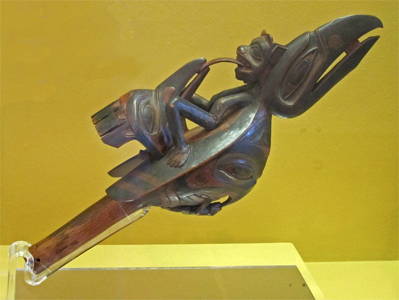
Chief's Dancing Rattle
Mid 19th century, Queen Charlotte Island, British Columbia, Canada
Haida
Wood
Photo: Haa900, 2010
Permission: Public Domain
Source: Honolulu Academy of Arts
Ravens as part of pipes

Haida argillite pipe with a raven and a human, both with inset eyes of abalone shell.
The Haida carvings of Haida Gwaii along the coast of British Columbia are notable aboriginal art treasures created from a type of a hard, fine, carbonaceous black silt argillite, sometimes called 'black slate'.
The black slate occurs only at a quarry on a Slatechuck Mountain in the upper basin of Slatechuck Creek, near the town of Skidegate on Graham Island. At one time, around 1900, it was shipped to Victoria for manufacturing; today the Haida have a monopoly on use of the argillite.
Argillite carvings are synonymous with Haida artwork and are one of the few art forms on the Northwest Coast that is the exclusive right of one cultural group. This artwork has been of high quality and prized around the world since the Haida first began carving it to trade and sell to sailors around 1800. Contemporary Haida carvers continue the tradition.
Photo: Don Hitchcock 2018
Source: Original, British Museum
Text: Wikipedia
Argillite smoking-pipe, Haida, 19th Century.
Height 56 mm, length 190 mm, width 27 mm.
( This piece has a human in the jaws of an animal, possibly a beaver, at the front, perhaps with the bowl of the pipe in its head, with a raven in the middle of the pipe, and the head of another human at the back.
It is not certain whether this is an actual functioning pipe, however. Towards the end of the production of these pieces, and especially with the type known as 'panel pipes', the smoking function was progressively abandoned, and the pieces became sculptures only. - Don )
Catalog: Argillite, Am,De.9
Photo: Don Hitchcock 2018
Source and text: http://www.britishmuseum.org/, © Trustees of the British Museum, CC BY-NC-SA 4.0
Argillite smoking-pipe with figures, Haida, 19th Century.
Length 194 mm, width 88 mm.
Wright (1982) mentions this pipe in support of her argument that argillite pipes were not sacred. According to Wright the combination of Euro-American figures and traditional Haida motifs in pipes like De.21 suggest that Haida pipe makers freely intermixed imagery in a way which would not be acceptable for sacred or secret objects. It is included on this otherwise 'Ravens' page for context.
It unusually includes a European sailor interlocking with Haida figures.
Catalog: Argillite, Am,De.21
Photo: © Trustees of the British Museum, CC BY-NC-SA 4.0, British Museum
Text: http://www.britishmuseum.org/, © Trustees of the British Museum, CC BY-NC-SA 4.0
Additional text: Wright (1982)
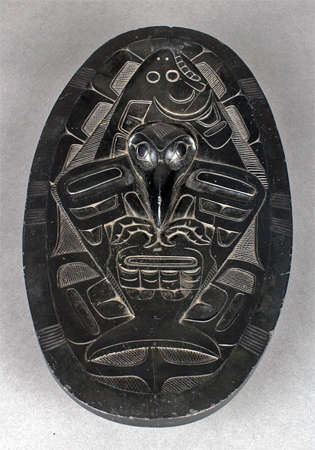
Platter, ca. 1900, unknown Haida artist, argillite.
( this platter displays a raven superimposed on a halibut - Don )
The Elizabeth Cole Butler Collection, no known copyright restrictions, 87.88.60
Photo and text: http://portlandartmuseum.us/mwebcgi/mweb.exe?request=record;id=25535;type=101#
This is an unusual wooden pipe, portraying just one figure, a raven.
The eyes, and the sun held in the beak, are of abalone shell, and abalone shell has been used as decoration on the upper beak and wings, and perhaps originally the tail as well.
Photo: Don Hitchcock 2018
Source: Original, British Museum
Text: Wikipedia
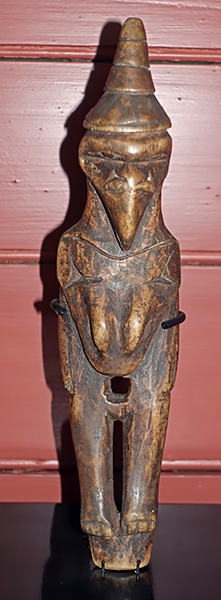
This is an unusual wooden carving consisting of a chimera of a raven and a human. It is standing, wearing a traditional hat of cedar bark.
The raven is all of one piece, and appears to form something of a cloak over the human figure, reaching from the head and shoulders down over the chest and abdomen.
In the pubic area a hole has been made, with uneven edges as though it were originally covered by some other carving.
Photo: Don Hitchcock 2018
Source: Original, British Museum
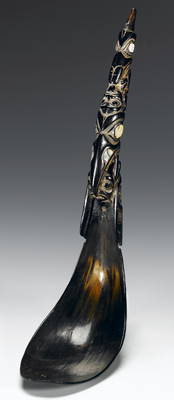
Northwest Coast Mountain Goat Horn Spoon
Composed of two sections, the tip of the handle carved with a raven with anthropomorphic body, an inverted human head with tongue extended between the bird's beak, followed by a larger raven, his beak curled around a human head, the wings extended to either side of the oval bowl.
The handle has abalone shell inlays and is secured to the bowl with a single copper pin, the underside of the bowl with an old collection label inscribed: 'Indian Spoon Naas River?…'
( Naas River is the home of the Tlingit Nation - Don )
Photo and text: http://www.bonhams.com/auctions/14589/lot/119/
Ravens as part of House Poles and Totem Poles



House Frontal Pole
Haida
Another example of classic Haida design is seen in the replica of a pole that once stood up against a house in Masset on the Queen Charlotte Islands, a village that bristled with some fifty poles during the late nineteenth century. Sometime before 1878 the house was abandoned, and in 1901 Dr. Charles F. Newcombe bought the pole for the provincial museum in Victoria, B.C.
It stood in Beacon Hill Park for many years until a windstorm sent it crashing, breaking the pole beyond repair. The pieces were given to the Museum of Anthropology, and some of them are now displayed on the walls of the foyer. The museum commissioned Jim Hart of Massett to replicate the pole, with Bill Reid acting as consultant.
"I wanted to experience all aspects of carving the first pole for which I'd be responsible," Jim Hart said, "so I began by involving myself in choosing the cedar log." When some rot subsequently showed up, he adzed it out and carefully fitted in a section of good wood. For ten months he worked long and often lonely hours carving the pole. At the top of the pole is Raven, then Frog, Sea Bear with its cub, an upside-down human, and Bear holding Frog in its mouth; small frogs peek through the cars of Grizzly Bear at the base, holding Sculpin.
Additional text below from http://www.rrnpilot.org/items/16413 :
Free standing house frontal pole with hollowed out back. Bilaterally symmetrical distributive bas-relief carving with painted details, in flat black and orange red.
From top is a standing raven with attached cone-shaped beak; head and shoulders of frog; sea bear with dog-fish like face on ears, wide orange-red tongue extending over fore-paws raised to chin; sea-bear cub with head to bottom and body over top of sea-bear body above with hind limbs of top sea-bear under and to sides; upside down human head with arms emerging at sides; bear head with frog emerging from mouth; grizzly bear with sculpin between forepaws and frog on each ear.
All eyes are black and round with black round or tapering oval outlines; eyebrow bands are black; eye and ovoid detail on raven wings are black; ears are outlined in black; mouths and nostrils are red-orange. Large longitudinal cracks, darkened areas and green growth along centre front. Bird droppings along areas of highest relief.
Poles erected in front of houses, or the carved structural components at the front of houses, display the crests of the families who own them. They represent a family's status and affiliations.
This pole is a copy of one which was moved from old Masset to Beacon Hill Park, in Victoria, by Newcombe, in 1901. The original pole was from house 34 (MacDonald) an unnamed house, possibly owned by 'Eagle' of 'The Rotten House People.' The fragments of the old pole came to UBC in 1948. These remained in storage until a skilled Masset carver could be recruited to carve a new pole. This new pole was raised on the Museum's grounds on October 2, 1982. The old fragments are still in storage.
The cedar log was donated by Western Forest Products. Log preparation was undertaken by Fred Davis, Mike Lepago and Pete Durnell. Bill Reid served as an advisor/artistic consultant. Wood scientists for Forintek provided technical guidance.
Made by Jim M. Hart (Maker) and Fred Davis (Technician) in British Columbia, Canada between August 1981 and October 1982
Identification Number: Nb1.487
Manufacturing Technique: machine sawn, painted, adzed and carved
Height 11.0 m, width 1.0 m, depth 0.9 m
Condition: good
Accession number: 865/1
Creation Date: between August 1981 and October 1982
Photo (left) and text: Stewart (1993)
Photo (centre): Don Hitchcock 2012
Photo (right) and additional text: http://www.rrnpilot.org/items/16413
Source: Display, Museum of Anthropology, University of British Columbia
Raven crest of red cedar from the summit of a pole or beam end.
Haida people, Alaska or British Columbia, 19th century.
Raven is a central crest and personality on the Northwest Coast. Human beings were discovered crawling out of a clam shell on the beach after Raven had helped to create the world.
He used a black pebble to form Haida Gwaii (the Queen Charlotte Islands). Raven is a gluttonous trickster, always greedy and creative. Eagle is his constant competitor for food.
Height 65 cm, length 219 cm, width 63 cm, weight 95 kg.
On the 13th September 1924, a consignment of objects from the Northwest Coast was sent to the Wellcome collection (via a Mr C. Thompson of 54a Wigmore Street) from Montreal on the SS Bolingbroke.
It is likely that this object was part of this consignment as the only object in 'Case No. 2', described on the shipping list held in the Wellcome Trust archives as 'One large Raven Totem top' and annotated with the number '28351'. The list also gives a place of origin for the piece, listed as 'Tongass 3'. Tongass is a region on the southern Alaskan-Canadian border, and the name originally referred specifically to a group of Tlingit people in the area, although Haida and Tshimshan groups also live nearby.
Catalog: Am1981,12.13
Photo: Don Hitchcock 2018
Source and text: Original, British Museum, http://www.britishmuseum.org/, © Trustees of the British Museum, CC BY-NC-SA 4.0
Donated by the Trustees of the Wellcome Historical Medical Museum.



House Frontal Pole
Haida
Another example of classic Haida design is seen in the replica of a pole that once stood up against a house in Masset on the Queen Charlotte Islands, a village that bristled with some fifty poles during the late nineteenth century. Sometime before 1878 the house was abandoned, and in 1901 Dr. Charles F. Newcombe bought the pole for the provincial museum in Victoria, B.C.
It stood in Beacon Hill Park for many years until a windstorm sent it crashing, breaking the pole beyond repair. The pieces were given to the Museum of Anthropology, and some of them are now displayed on the walls of the foyer. The museum commissioned Jim Hart of Massett to replicate the pole, with Bill Reid acting as consultant.
"I wanted to experience all aspects of carving the first pole for which I'd be responsible," Jim Hart said, "so I began by involving myself in choosing the cedar log." When some rot subsequently showed up, he adzed it out and carefully fitted in a section of good wood. For ten months he worked long and often lonely hours carving the pole. At the top of the pole is Raven, then Frog, Sea Bear with its cub, an upside-down human, and Bear holding Frog in its mouth; small frogs peek through the cars of Grizzly Bear at the base, holding Sculpin.
Additional text below from http://www.rrnpilot.org/items/16413 :
Free standing house frontal pole with hollowed out back. Bilaterally symmetrical distributive bas-relief carving with painted details, in flat black and orange red.
From top is a standing raven with attached cone-shaped beak; head and shoulders of frog; sea bear with dog-fish like face on ears, wide orange-red tongue extending over fore-paws raised to chin; sea-bear cub with head to bottom and body over top of sea-bear body above with hind limbs of top sea-bear under and to sides; upside down human head with arms emerging at sides; bear head with frog emerging from mouth; grizzly bear with sculpin between forepaws and frog on each ear.
All eyes are black and round with black round or tapering oval outlines; eyebrow bands are black; eye and ovoid detail on raven wings are black; ears are outlined in black; mouths and nostrils are red-orange. Large longitudinal cracks, darkened areas and green growth along centre front. Bird droppings along areas of highest relief.
Poles erected in front of houses, or the carved structural components at the front of houses, display the crests of the families who own them. They represent a family's status and affiliations.
This pole is a copy of one which was moved from old Masset to Beacon Hill Park, in Victoria, by Newcombe, in 1901. The original pole was from house 34 (MacDonald) an unnamed house, possibly owned by 'Eagle' of 'The Rotten House People.' The fragments of the old pole came to UBC in 1948. These remained in storage until a skilled Masset carver could be recruited to carve a new pole. This new pole was raised on the Museum's grounds on October 2, 1982. The old fragments are still in storage.
The cedar log was donated by Western Forest Products. Log preparation was undertaken by Fred Davis, Mike Lepago and Pete Durnell. Bill Reid served as an advisor/artistic consultant. Wood scientists for Forintek provided technical guidance.
Made by Jim M. Hart (Maker) and Fred Davis (Technician) in British Columbia, Canada between August 1981 and October 1982
Identification Number: Nb1.487
Manufacturing Technique: machine sawn, painted, adzed and carved
Height 11.0 m, width 1.0 m, depth 0.9 m
Condition: good
Accession number: 865/1
Creation Date: between August 1981 and October 1982
Photo (left) and text: Stewart (1993)
Photo (centre): Don Hitchcock 2012
Photo (right) and additional text: http://www.rrnpilot.org/items/16413
Source: Display, Museum of Anthropology, University of British Columbia


The Pole of Tatentsit
Pole carved in high relief out of cedar wood, and painted.
Depicts from bottom to top: a raven, human holding a white and black copper, Sisiutl with a supernatural creature in its tail and a frog(?) in its mouth, an eagle and human. The large protruding beak of the raven has been attached. The entire surface is painted in black, white, green and red with Northwest Coast stylised forms.
(Sisiutl is the god of warrior invincibility, a magic war-canoe that can go underground (Winalagalis), and guardian of the house of the sky people - Wikipedia )
Free standing totem poles such as this were usually memorial or commemorative poles erected in honour of a person who had died, usually by the successor to his name. The beings represented on Kwakwaka'wakw poles are those beings from mythical times who became, or were encountered by, the ancestors of those who are being commemorated, whose family claimed the figures as crests. Crests could also be claimed as marriage gifts.
Barbeau called it The Pole of Tatentsit. According to Barbeau, the pole was erected for, or by, T'at'entsit on the occasion of a large potlatch. The pole was re-adzed and re-painted by Kwakwaka'wakw carver Mungo Martin before shipping in 1947. Repainted and repaired by Ellen Neel (1949) and by Mungo Martin (1950-51). It stood at Totem Pole Park, UBC Campus until it was re-located to the Museum's Great Hall c. 1976.
Thunderbird is a supernatural bird identifiable by the presence of ear-like projections or horns on the head, and a re-curved beak. Sisiutl is a serpent often represented with two heads, and associated with wealth and power. Raven is represented with a long, straight beak, sometimes slightly squared or rounded at the tip.
Raven Chief is holding a copper, a symbol of wealth.
Made by Charlie James (Maker) in Fort Rupert, British Columbia, Canada and Tsaxis, British Columbia, Canada during 1900
Collected by Marius Barbeau and Arthur Price during 1947
Owned by Committee on Totem Poles before 1947
Identification Number: A50038
Height 12.2 m, width 2.11 m, depth 0.83 m
Made in: Fort Rupert, British Columbia, Canada and Tsaxis, British Columbia, Canada
Condition: fair
Accession number: 2106/5
Culture: Kwakwaka'wakw: Kwagu'l
Photo: two images stitched together, Don Hitchcock 2012
Text: http://www.rrnpilot.org/items/17827
Source: Display, Museum of Anthropology, University of British Columbia
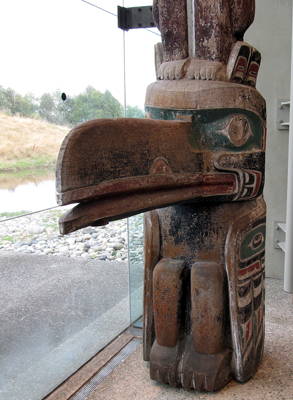
Raven from the Pole of Tatentsit shown above.
Identification Number: A50038
Photo: Maria Hitchcock 2012
Source: Display, Museum of Anthropology, University of British Columbia
A House Portal Pole is a tall pole standing at the centre of the house front. It rose above the house with the open mouth of the creature at the base forming the entrance. when European style doors were later built into houses no opening was cut and the pole became a frontal pole.
Text above: http://www.sfu.ca/brc/art_architecture/totem_poles.html

Chief Skow's Sea Monster House with faded paint and frontal pole in place. This house was later re-modelled with a raven crest painting and a raven's head protruding from above the entryway.
Language group: Kwakwaka'wakw
Village: Gwayasdums / Gwaestums (Gilford Island)
Photo: © Sam Barrett, 1915
Permission and text: Courtesy George MacDonald, Director, Bill Reid Centre for NWC Art Studies at Simon Fraser University, Vancouver, BC.
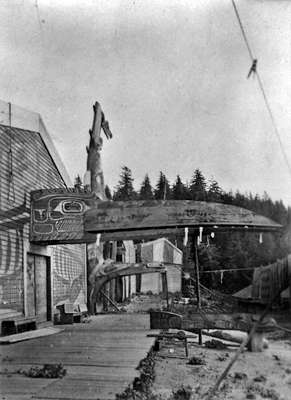
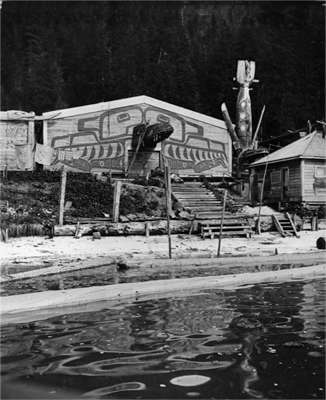
The Raven House housefront was formerly painted as a sea monster but has been re-created here as a raven with its head protruding from above the entry way. The mouth of the raven was rigged to open and be used as an entry during potlatches. There is a large pole carved by Mungo Martin on the far side of the house which formerly stood at the entry.
(Note the carving of a Sculpin, a bony fish, in front of the house, seen clearly in the photo on the left. This is a fascinating sculpture, essentially a totem pole designed to be displayed horizontally - Don )
By 1915 Chief Scow had become a widower and married a noble Heiltsuk woman. The old Sea Monster House was torn down and was reconstructed on the same spot. Similarly to the crest of the Sea Monster, included in his new wife's dowry was the Raven image painted on the new structure. As the pictures show, the frontal pole was kept but moved to the side of the house.
This housefront is painted as a raven with a head protruding above the entry way. There is a large pole standing on the far side of the house which once stood at the entry.
Scow's House - Skow House, Gwaestums
Language group: Kwakwaka'wakw
Village: Gwayasdums (Gilford Island)
Photo: © C. F. Newcombe, 1917
Permission and text: Courtesy George MacDonald, Director, Bill Reid Centre for NWC Art Studies at Simon Fraser University, Vancouver, BC.
Raven Paintings

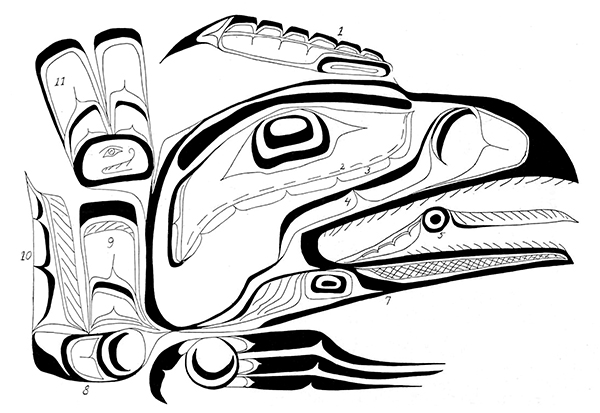
Painting for a house-front representing a raven, Kwakiutl (Kwakwaka'wakw).
This represents the painting from a housefront showing a raven in profile. This painting appears on the right and left of the doorway; the beaks facing the door, as in the upper drawing.
( note that the door is schematic only. It may have been of quite different dimensions to that shown. The actual doors ranged from a quite narrow door where the residents entered through an arch in the base of a carved house post made of a single cedar log, through to very large double doors in a 'Big House' - Don )
1. The raised tuft on the head of the raven
2. Feathers
3. The facial bones
4. The skin over the beak
5. A joint (?) in the tongue
6. The skin over the lower jaw
7. The supposed joint at the base of the tongue
8. Represents the shoulder joint
9. Inner feathers
10. The long wing feathers.
11. represents the tail with a single face as a joint, according to these conventions.
It will be noticed that the inner feathers, 9, are rounded, while the wing feather, 10, has a sharp point, which accords with the standard designs adopted by the Kwakiutl (Kwakwaka'wakw).
Photo and text: Boas (1927)
Upper photo assembled by Don Hitchcock after Boas (1927)
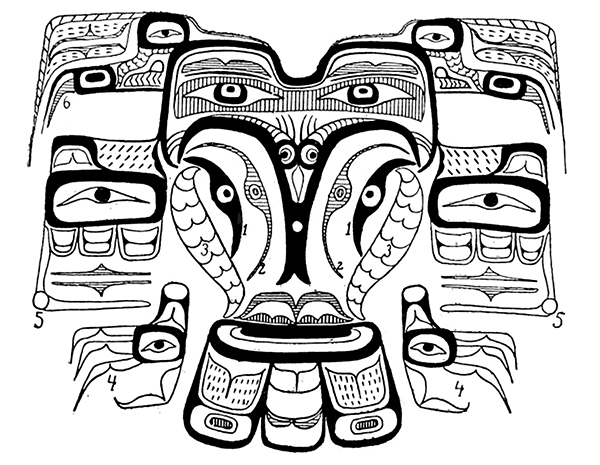
Another house-painting of the Kwakiutl, representing the raven. The central portion of the figure is occupied by the head of the raven split from its lower side upward so that the two halves cohere along the upper edge of the beak.
The two halves of the head have been folded outward, so that the two halves of the tongues (2) and the two lower jaws (1) appear on each side of the central line. The two halves of the lower side of the body are shown extending in a curved line (3) from the corners of the mouth towards the tail, which latter has not been cut. The wings
have been considerably reduced in size, and pulled upward so that they appear over each upper corner of the head. The legs (5) occupy the right and left lower parts of the painting, the feet (4) being disconnected from the thin legs.
( note the way that the design has been made highly symmetrical by duplication and separation of various parts of the design, such as the head, and their careful arrangement into a coherent whole - Don )
Photo and text: Boas (1927)
Raven Tattoo
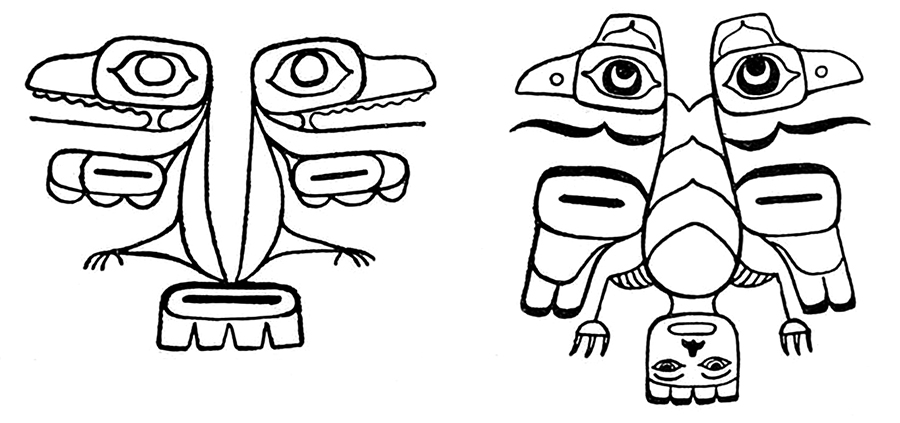
In these tattoos representing the duck (left) and the raven (right), the tail is left intact. However the duck has been
split along the back so that the two halves of the body do not cohere except in their lowest portions, while the two halves of the raven are left in contact up to the head.
Photo and text: Boas (1927)
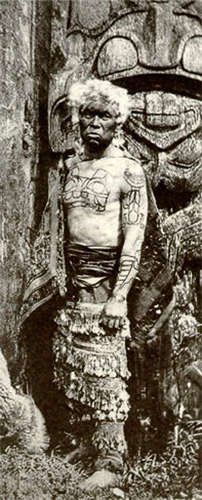
Haida Chief Xa'na of Grizzly Bear House with tattooed hereditary crests, Masset, British Columbia, 1881. Photograph by Edward Dossetter.
Language group: Haida
Village: Masset, Graham Island, Queen Charlotte Islands
Photo: © Edward Dossetter, 1881
Source: http://www.vanishingtattoo.com/tattoo_museum/haida_tattoo_images.html
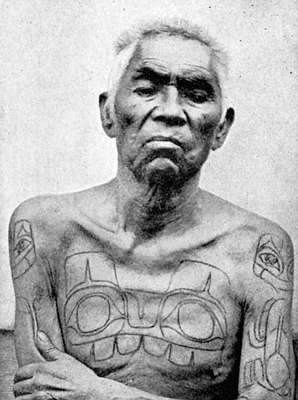
Haida Chief Xa'na of Grizzly Bear House with tattooed hereditary crests
Showing the characteristic figures used in tattooing.
Photo and text: Collison (1915)
Permission: Public Domain
References
- Anderson L., 1989: Double Masks of the Northwest Coast of America in Museum Collections, Thesis for the Degree of Master of Arts in the Faculty of Graduate Studies (Anthropology), University of British Columbia, June 1989
- Azéma M. et al., 2012: L'Art Paléolithique de la Baume Latrone (France, Gard): Nouveaux éléments de datation, INORA, 2012, No. 64
- Boas F., 1927: Primitive Art,Institute for Comparative Culture Research, Oslo, 1927
- Collison W., 1916: In the wake of the war canoe; a stirring record of forty years' successful labour, peril & adventure amongst the savage Indian tribes of the Pacific coast, and the piratical headhunting Haidas of the Queen Charlotte Islands, B.C., Toronto, Musson Book Co.
- Gould J., 1973: The iconography of the Northwest Coast Raven Rattle, Thesis submitted in partial fulfilment of the requirements for the degree of Master of Arts in the Department of Anthropology and Sociology, The University of British Columbia October, 1973.
- Pigeaud E., 2013: Grotte de la Baume Latrone, aux racines de l'art préhistorique, https://www.academia.edu/9303786/La_Baume_Latrone_Aux_racines_de_l_art_pr%C3%A9historique
- Wright R., 1982: Haida Argillite: Carved For Sale, American Indian Art Magazine (Vol.8, No.1) (pp.48-55), Scotsdale, Arizona, 1982
Back to Don's Maps
 Back to Archaeological Sites
Back to Archaeological Sites
